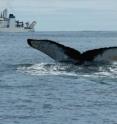New study finds most North Pacific humpback whale populations rebounding
The number of humpback whales in the North Pacific Ocean has increased since international and federal protections were enacted in the 1960s and 70s, according to a new study funded primarily by NOAA and conducted by more than 400 whale researchers throughout the Pacific region. However, some isolated populations of humpbacks, especially those in the Western Pacific Ocean, have not recovered at the same rate and still suffer low numbers.
The new research reveals that the overall population of humpbacks has rebounded to approximately 18,000 to 20,000 animals. The population of humpback whales in the North Pacific, at least half of whom migrate between Alaska and Hawaii, numbered less than 1,500 in 1966 when international whaling for this species was banned. In the 1970s, federal laws including the Marine Mammal Protection Act and the Endangered Species Act provided additional protection.
“NOAA is proud to have played a key role in initiating and funding this study,” said retired Navy Vice Adm. Conrad C. Lautenbacher, Ph.D., under secretary of commerce for oceans and atmosphere and NOAA administrator. “It is only through this type of international cooperation that we can gauge our success and measure what additional work needs to be accomplished to protect highly migratory marine mammals.”
The results of this new report come from SPLASH (Structure of Populations, Levels of Abundance and Status of Humpbacks), an international effort involving more than 50 organizations. Launched in 2004, the project determined whale migratory patterns and estimated population sizes by using a library of 18,000 photographs of whale flukes to identify 8,000 individual whales.
Cascadia Research in Olympia, Wash., the central coordinator for the SPLASH project, matched photographs from six different feeding and breeding areas. By matching whale flukes photographed in their feeding areas with those photographed in the wintering areas, researchers were able to determine the patterns of individual whale movements, as well as estimate the sizes of different populations.
In addition to whale fluke photographs, SPLASH researchers collected more than 6,000 biopsy samples for studies of genetics and pollutants, along with thousands of additional photographs to determine how levels of scarring from line entanglement and ship strikes vary among regions. The samples, which are yet to be analyzed, will provide valuable insights into the complex population structure and current threats to further recovery.
Source: NOAA National Marine Fisheries Service
Other sources
- Resurgent Humpbacks On Comeback Trailfrom CBSNews - ScienceFri, 23 May 2008, 16:21:13 UTC
- Humpbacks make a comeback in Pacificfrom CBC: Technology & ScienceFri, 23 May 2008, 12:14:04 UTC
- Study: Humpback whale population risesfrom MSNBC: ScienceFri, 23 May 2008, 10:21:07 UTC
- Study: Humpback whale population risesfrom AP ScienceFri, 23 May 2008, 8:28:05 UTC
- New study finds most North Pacific humpback whale populations reboundingfrom Biology News NetThu, 22 May 2008, 5:14:08 UTC
- New study finds most North Pacific humpback whale populations reboundingfrom PhysorgWed, 21 May 2008, 21:21:43 UTC
- Most North Pacific Humpback Whale Populations Reboundingfrom Science DailyWed, 21 May 2008, 21:21:16 UTC
